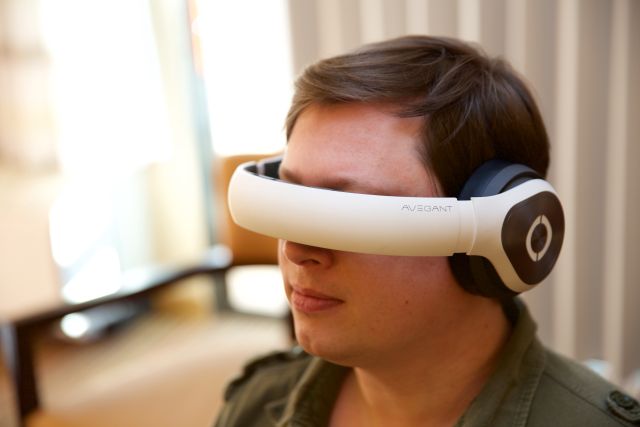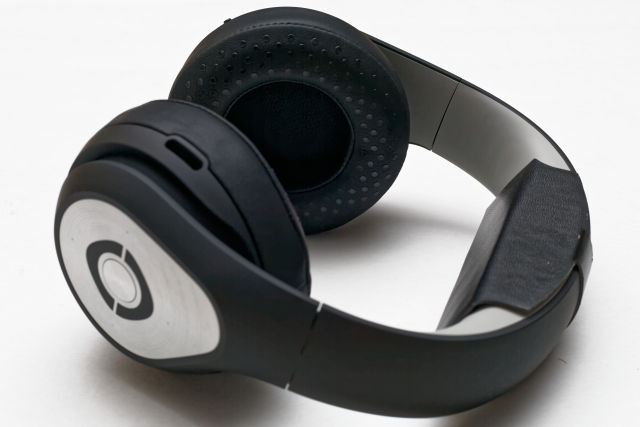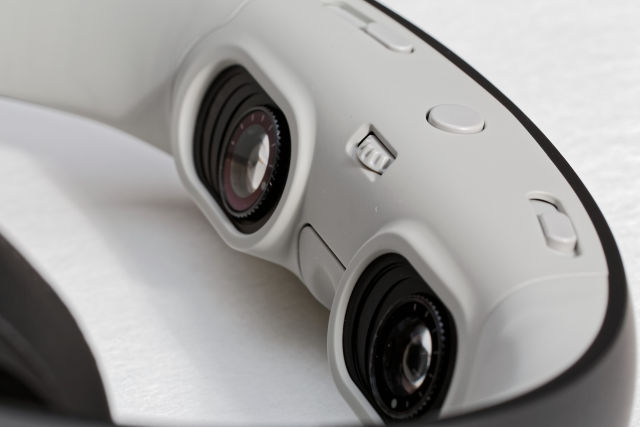
| Specs at a glance: Avegant Glyph Founder's Edition | |
|---|---|
| Display | Twin 1280×720 MEMS DLP |
| Field of view | Approximately 40° |
| Inputs | MicroHDMI (audio and video), stereo mini headphone (audio only), microUSB (charging) |
| Battery | 2060mAH Li-Ion (advertised 4-hour life) |
| Head tracking | 9 axis IMU |
| Price | $699 US |
| Availability | 8-10 weeks |
The Avegant Glyph is a screen that you wear on your face. That’s the simplest way to describe it. The whole device looks like a pair of outsized Beats headphones, complete with a huge chunky body and thick plastic headband; the parts that go on your ears are indeed headphones, but that huge headband hides a 720p DLP screen (though "screen" isn’t quite right, as we’ll see) and the optics necessary to make the display work.
When you put it on, you look a lot like you’re wearing someone’s parody of what a VR headset is supposed to look like (personally, I think the effect rather resembles the popular "cyber woman with corn" stock photo). But the technology actually delivers a very high fidelity image—and for a first-generation hardware project borne of a Kickstarter, even delivering a product at all can be considered a success. Viewed through that lens, the Glyph is a hit.
But after spending a week with a "Founder’s Edition" version of the headset, I’m not entirely sure I’d want to spend the money for one—and it might not be for the reason you’re expecting.

The physicality of the thing
In contrast to the visibly taped together engineering prototype I tried at CES two years ago, the shipping version of the Glyph feels like a slickly manufactured product. It’s clear that care was lavished on the device’s design to make sure it looks good and feels good to use: the out-of-box experience is nice, with the packaging unfolding logically and without weird fiddly bits or frustrating hiccups, and the Glyph itself is a lightweight yet solid piece of smooth plastic. The seams aren’t rough. It feels sturdy without feeling heavy. The faux leather over the earphones is soft and smooth, with even stitching.

The Glyph comes out of the box with its optics protected by a magnetic-snap suede slipcover, which you’ll want to have affixed if you decide to use the Glyph in "headphone" mode. When used this way, the Glyph sits on your head like any other set of cans—though the headband where the optics live is necessarily inflexible, and most of the "give" in the device is on the sides of the headband arms.
To actually watch video on the thing, though, you have to spend quite a bit of time on adjustments and tweaks. You can just remove the optical cover and rotate the thing down onto your nose, but your experience will be a lot better if you attach one of the four included eyeglass-style nose bridges to the device (the nose bridges snick magnetically into place in a very satisfying way—a thoughtful design touch for a component that might be removed frequently). Then you press the button in the center of the band to release the spring-loaded lenses to their viewing position; they deploy a few millimeters forward with a nice click. You then need to adjust the interpupillary distance (IPD) sliders on top of the Glyph so that the two lenses line up with where your eyeballs are.
Once that’s done, you can twist the lenses to adjust the focus of the image as needed. The focusing mechanism is designed to address a pretty wide range of myopia and hyperopia, with a diopter adjustment range of +1 to -7, so folks who wear glasses can use the Glyph without needing to keep their glasses in place; with my LASIK-corrected 20/20 vision, I simply unfocused to infinity and fiddled with the lenses until the test image on the Glyph’s screen looked sharp. Finally, you can secure an optional velcro head-strap between the two ear cans to take some of the Glyph’s resting weight off the bridge of your nose.

I’m wearin’ it
The Avegant spec page for the Glyph lists its weight as 434g (15.3oz, or just a hair under one pound), and I found that it took probably twenty or thirty minutes to get the Glyph to a comfortable spot on my head. There are a lot of settings to play with—the IPD sliders required a fair amount of moving before I found a comfortable distraction-free spot, and the nose bridge can be dialed up and down to adjust how it sits and where the image goes. Though light at first, the headset was heavy enough that wearing it for long periods of time left me with an uncomfortable amount of weight pressing on my nose bridge, even with the head strap in place. The most comfortable way to use the Glyph long-term was actually with my chin pressed against my chest, which puts most of the Glyph’s weight on the head strap and off of the nose.
The image generated by the Glyph’s projection array shows up as a 16:9-ratio rectangle. I tried a whole bunch of different ways to get a camera into position to actually photograph the image through the eyepiece but ultimately was unable to do so, so you’ll just have to rely on my words unless you have access to a Glyph to try it out for yourself. (This is in fact one of the most annoying things about head-mounted displays in general: it’s just damn hard to share the experience in a meaningful way.)
The image doesn’t come anywhere near close to filling up your entire field of view. Some quick estimation and flipping the thing on and off quickly shows that the "screen" is about the same effective size and shape as that of a 13-inch laptop screen held at arm’s length. It’s also quite easy to see the real world above and below the band, which is handy if you’re using the Glyph as a display for a computer or smartphone, since you can easily look down to position your hands over the keys or trackpad.
The correct eyeline you need to achieve to get the brightest image seems to be slightly "down" from center—the Glyph lenses are angled slightly upward, so you need to position the lenses just below the centerline of your eyes for the image to pop into full brightness. For me with how my face is shaped, this puts the nose bridge directly on the cartilage of my nose instead of on the bone; if you have a particularly small or flat nose, you might need to mess around quite a bit with positioning to get everything lined up.

The device’s controls are on the surface of the headphones covering your ears. The Glyph’s volume and brightness are controlled by pressing small raised switches on the right ear, and the Glyph can be switched to "3d mode" or have its IMU-based head tracking enabled or disabled with switches over the left ear.
reader comments
54